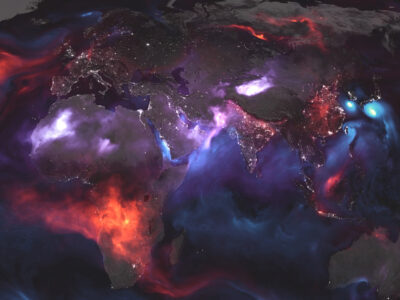Our team is planning to recover and analyze ice cores from glaciers on opposite sides of the tropical Pacific Ocean: Puncak Jaya in Papua-Indonesia (4,884 meters above mean sea level) and Nevado Haulcán, Peru (6,100 meters.). Puncak Jaya offers the only potential opportunity to acquire an ice core history from the western side of what oceanographers call the Pacific Warm Pool–the single largest heat source to the global atmosphere. So, we hope to extract and interpret climatic histories covering a large part of the world. The Peru ice core was recovered in 2009; we launch the Papua expedition tomorrow.
Measurements from satellite images show that between 2000 and 2002, Puncak Jaya decreased from 2.326 square kilometers to 2.152 square kilometers, or by 7.48 percent. If this rate of ice loss continues, the ice will disappear in a few decades or less. Hence, we race against time.
The climate of the tropical Pacific Ocean is dominated on multiyear time scales by the El Nino-Southern Oscillation (ENSO) a periodic warming and cooling of the ocean surface. Assessments of future climate changes will require records of the natural variability in ENSO. Ice cores show changes in temperature and rainfall from year to year, so they provide high-resolution climatic and environmental histories essential for understanding the complex interactions within earth’s climate system.
As the histories from Puncak Jaya and Hualcán come from opposite sides of the atmospheric/oceanic system that gives rise to ENSO, their integration will provide the first opportunity to use tropical ice core histories to examine the nature of tropical climate variability in greater detail. Having time series from Indonesia and Peru, we can derive an index similar to the ENSO index, and can have the history of the trend and its frequency. We will also be able to extract new information on ENSO-linked climate phenomena. The most important of these is the Austral-Asian monsoon system, which waters crops for billions of people, but can also bring floods and droughts. Abrupt events seem to punctuate it, such as a drought about 4,200 years ago that is observed in numerous tropical climate records.
Ice cores from Papua and Peru can also be used as a proxy of the Indonesian throughflow, the flow of water from the Pacific to the Indian Ocean via the seas around Indonesia. (See my web page for details of my research on this.) Because the Indonesian throughflow is affected by ENSO, the ice core time series will tell us about it. During the La Niña phase (warm in Papua, cold in Peru), throughflow may increase up to 20 Sverdrups (a flow of 1Sverdrup equals about 264 million gallons per second); during El Niño (cold in Papua and warm in Peru) the throughflow reduces to only 2 Sverdrups. Hence, we can use ice core data to understand what is going in both oceans.
It will be months before we can start interpreting data, but tomorrow will start the first step: launching the expedition to get the ice cores.



